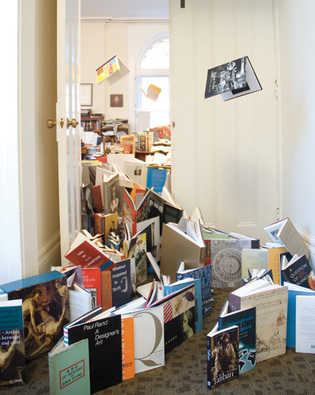 loading
loading
featuresPress runThe long and varied career of Yale University Press, from Dylan and de Kooning to a history of the hamburger. Alex Beam ’75 is a Boston Globe columnist and the author, most recently, of A Great Idea at the Time: The Rise, Fall, and Curious Afterlife of the Great Books.
 Mark MorosseThe office of YUP director John Donatich. (Books added.) View full imageYale University Press is celebrating its hundredth anniversary; perhaps some self-congratulation is in order. By way of being 100, YUP has spewed forth a blizzard of publicity flyers, assembled a star-studded conference on "Why Books Still Matter" -- Why X Matters is the catchphrase of a YUP series in gestation -- and has even commissioned what might be called its own vanity-press history, A World of Letters, by the noted bibliophile Nicholas Basbanes. What do they say on the basketball court? It ain't bragging if you done it. YUP has a lot to be immodest about. It's a $35 million business, which makes it bigger than Farrar, Straus, and Giroux, these days a division of Macmillan. Its staff of 130 (including 15 editors) is divided between New Haven and London. Thanks to a combination of $1.7 million in endowment income, some savvy grantsmanship, and judicious management, YUP breaks even financially and doesn't drain the university coffers. Yale is now the largest university press in the country, as measured in books published, and it regularly plants books on best-seller lists around the country. In a world where several smaller university presses have failed and many are running on fumes, YUP has not merely endured, it has prevailed. If you have read a good book lately, it is altogether possible that YUP's distinctive Paul Rand-designed logo sits discreetly on its spine. A partial list of recent hits would include Edmund Morgan's biography of Benjamin Franklin, Jonathan D. Sarna's American Judaism, and Ahmed Rashid's Taliban, all of which appeared on the New York Times or Los Angeles Times best-seller lists. The press's reissue of A Little History of the World, a 1935 work by the art historian E. H. Gombrich, sold 150,000 copies. "That's a lot for any book, much less a university press book," marvels Sara Nelson ’78, the editor in chief of Publishers Weekly. To survive, the press has changed radically over time. The huge, grant-funded academic undertakings that characterized much of its existence -- the Horace Walpole correspondence, the Benjamin Franklin papers, the Annals of Communism project -- are still in business, but they no longer occupy center stage. And it's doubtful that today's YUP would plunge into a disastrous high-stakes gamble like the 1965 publication of the Vinland Map, purportedly a 500-year-old sketch of the New World by visiting Vikings. ("The document . . . remains a matter of continuing contention," in Basbanes's judicious phrasing.) In the very near future, it will be quite unlikely that YUP, or any of its competitors, publishes your brilliant dissertation, even if you have taken the time to translate it from Academic into English. Or if they do publish it, it won't be in book form. A half-century ago, practically any abstruse monograph could count on at least a thousand "standing orders" from the nation's research libraries, but no longer. "Nowadays, the more narrow the monograph, the lower the chance of selling even a few hundred copies," says YUP publishing director Tina Weiner. "People are still publishing these books, but very soon, they will be published electronically, maybe with no print editions whatsoever." Weiner's boss, YUP director John Donatich, estimates that about a third of the 300 to 400 books he publishes each year are in the academic division. "That kind of publishing has diminished as the core of the business, but not as the soul of the press," he says. "We'll take an important book, but we won't take a book just because a professor needs to get ahead in his or her career. We're publishers, not career counselors. Fifty years ago, that might have been different."
|
|